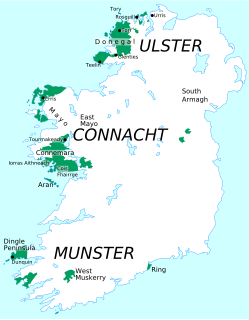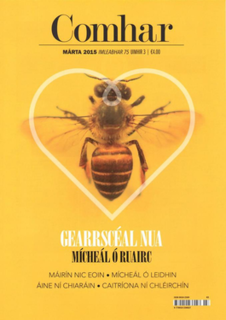This article needs additional citations for verification .(September 2008) |
Eoghan Ó Tuairisc (Eugene Rutherford Watters) (3 April 1919 – 24 August 1982) was an Irish poet and writer.
This article needs additional citations for verification .(September 2008) |
Eoghan Ó Tuairisc (Eugene Rutherford Watters) (3 April 1919 – 24 August 1982) was an Irish poet and writer.
Eugene Rutherford Watters was born at Dunlo Hill, Ballinasloe, County Galway, to Thomas Watters, a soldier, and his wife, Maud Sproule. [1] His second name came from his grandfather, Rutherford Sproule. [2]
He was educated at Garbally College. His entered St. Patrick's Teacher Training College, Drumcondra in 1939, graduating with a Diploma in Education in 1945. He was awarded an MA, by University College Dublin in 1947.
Ó Tuairisc held a commission in the Irish Army during the Emergency from 1939 to 1945. He was a teacher in Finglas, Co. Dublin from 1940 to 1969. From 1962 to 1965, he was editor of Feasta, the journal of Conradh na Gaeilge. His first wife, the Irish artist Una McDonnell, died in 1965. The following five years were an unsettled period of limited productivity, changing residence and jobs, and, ultimately, serious depression. [3]
In 1972 he married the writer Rita Kelly, also of Ballinasloe. They lived in the lock house at the Maganey Lock on the Barrow River that Ó Tuairisc had bought near Carlow town. The plaque on the wall erected by his wife states "He was happy here. Lux Aeterna". [4] Kelly survived him on his death in 1982. [5]
He wrote novels, verse, drama and criticism in both Irish and English. His first major publication was his controversial novel Murder in Three Moves, followed by Irish-language prose epic L'Attaque, which won an Irish Book Club award. Both works had a strong poetic flavour. His next book was a volume of verse entitled Week-End.
His narrative poem Dermot and Grace, an Irish version of Venus and Adonis , is considered his finest work.
Ó Tuairisc produced little during the five years following McDonnell's death. In 1981 he published The Road to Brightcity: and other stories (Swords: Poolbeg Press, 1981), a translation of nine of the best short stories written originally in Irish by Máirtín Ó Cadhain. Also in 1981, he and Rita Kelly published a joint collection of their poems, Dialann sa Díseart. [6]
Like Diarmaid Ó Súilleabháin, he "challenged the critical orthodoxy by openly proclaiming that their standards could not be those of the Gaeltacht and by demanding a creative freedom that would acknowledge hybridity and reject the strictures of the linguistic purists." [7]
Eoghan Ó Tuairisc was an inaugural member of Aosdána, when it was founded in 1981, and the first of its members to die. [8] He was a recipient of an Arts Council of Ireland prize, as well as an Abbey Theatre prize for a Christmas pantomime in Irish. A bibliography of Ó Tuairisc's work, together with biographical information, was published in Irish in 1988. [9]
Although Irish has been used as a literary language for more than 1,500 years, and modern literature in Irish dates – as in most European languages – to the 16th century, modern Irish literature owes much of its popularity to the 19th century Gaelic Revival cultural movement. Writers in Irish have since produced some of the most interesting literature to come out of Ireland, supplemented by work produced in the language abroad.

The first Irish prose fiction, in the form of legendary stories, appeared in the Irish language as early as the seventh century, along with chronicles and lives of saints in Irish and Latin. Such fiction was an adaptation and elaboration of earlier oral material and was the work of a learned class who had acquired literacy with the coming of Latin Christianity. A number of these stories were still available in manuscripts of the late medieval period and even as late as the nineteenth century, though poetry was by that time the main literary vehicle of the Irish language.
Events in the year 1964 in Ireland.
Máirtín Ó Direáin was an Irish poet. A native of the Aran Islands Gaeltacht, Ó Direáin later spent time working in Galway and Dublin, where he upheld a connection to Gaelic affairs through Conradh na Gaeilge and Taibhdhearc na Gaillimhe. A significant theme of his poetic works deals with the tensions between the urban and rural, modernity and tradition, the English-speaking world and Gaeldom.

Máirtín Ó Cadhain was one of the most prominent Irish language writers of the twentieth century. Perhaps best known for his 1949 work Cré na Cille, Ó Cadhain played a key role in bringing literary modernism to contemporary Irish language literature. Politically, he was an Irish nationalist and socialist, promoting the Athghabháil na hÉireann, through Gaelic culture. He was a member of the post-Civil War Irish Republican Army with Brendan Behan during the Emergency.

Connacht Irish is the dialect of the Irish language spoken in the province of Connacht. Gaeltacht regions in Connacht are found in Counties Mayo and Galway. Connacht Irish is also spoken in the Meath Gealtacht Ráth Chairn and Bailie Ghib. The dialects of Irish in Connacht are extremely diverse, with the pronunciation, forms and lexicon being different even within each county. The Irish of South Connemara is often considered the "standard" Connacht Irish owing to the number of speakers however it is unique within Connacht and has a lot more idiomatic connection to extinct dialects in North Clare. Words such as "dubh" and snámh tend to be pronounced with a Munster accent in South Connemara whereas in Joyce Country, Galway City and Mayo they are pronounced with the Ulster pronunciation. In addition to this the standard in Connacht would be to pronounce the words "leo" and "dóibh" as "leofa" and "dófa" however in South Connemara and Aran they are pronounced "Leothab" and "dóib". Lexical and pronunciation differences exist within Mayo with Tourmakeady featuring an "í" sound in vowel endings much more commonly. In addition to this the lexicon of Dún Chaocháin to the east of Belmullet tends to be far more Ulster influenced than that of Eachléim and there is a huge Ulster influence on the dialect of North Mayo in general owing to historic migration. The Irish of Eachréidh na Gaillimhe and Dúiche Sheoigheach tend to share more phonetic commonalities with neighbouring Mayo than with South Connemara

Proinsias Mac Aonghusa was an Irish journalist, writer, TV presenter and campaigner.
Dr Tomás Mac Síomóin is an Irish doctoral graduate of Cornell University, New York, who has worked as a biological researcher and university lecturer in the USA and Ireland. He has worked as a journalist, as editor of the newspaper Anois and for many years he was editor of the literary and current affairs magazine, Comhar. He writes in Irish and has published both poetry and fiction in that language.

Comhar is a prominent literary journal in the Irish language, published by the company Comhar Teoranta. It was founded in 1942, and has published work by some of the most notable writers in Irish, including Máirtín Ó Cadhain, Seán Ó Ríordáin, Máirtín Ó Direáin, Máire Mhac an tSaoi and Brendan Behan. Comhar also publishes books in Irish.
Corn Uí Riada is the premier sean nós singing competition at Oireachtas na Gaeilge, an annually held arts festival of Irish culture. It is named in honour of the composer and founder of the legendary male choir Cór Chúil Aodha, Seán Ó Riada. A Cóisir Uí Riada is held whilst tuning into the broadcast of Corn Uí Riada, on the internet.
Rita Kelly is an Irish poet from Ballinasloe in eastern County Galway who now lives in an old lock house along the river Barrow between Athy and Carlow. She has published several collections of poetry and has been featured in a number of magazines and journals. Her poems Mé sa ghluaisteán leat and Is bronntanas na maidine thú were featured in Filíocht Ghrá na Gaeilge. She was married to the writer Eoghan Ó Tuairisc from 1972 until his death in 1982.

Cathal Ó Searcaigh, is a modern Irish language poet. His work has been widely translated, anthologised and studied. "His confident internationalism", according to Theo Dorgan, has channelled "new modes, new possibilities, into the writing of Irish language poetry in our time".

Feasta is an Irish-language magazine that was established in 1948. Its purpose is the furtherance of the aims of Conradh na Gaeilge, an objective reflecting the cultural nationalism of the language movement, and the promotion of new writing. Feasta describes itself as a review of Irish thought, literature, politics, and science. Until recently it was supported financially by Foras na Gaeilge, but this support was withdrawn because of a review of funding priorities. At present the magazine relies on its own resources.
Máirtín Ó Murchú is an Irish professor of Celtic studies and emeritus professor of the Dublin Institute of Advanced Studies. He previously also was Director of the School of Celtic at DIAS and a Professor of Irish at Trinity College Dublin.
Máirín Nic Eoin, Irish academic and scholar.
Seán Ó Cearnaigh is an Irish academic and scholar. He taught at the Dublin Institute for Advanced Studies from 1990–94, and has published books on the Irish language.
Diarmaid Ó Súilleabháin was an Irish language writer whose chosen theme was contemporary urban life. He is acknowledged as an important Irish language modernist. He was also active in the Irish republican movement and a member of Sinn Féin.
Donncha Ó Céileachair was a prominent writer in the Irish language. He and his sister, Síle Ní Chéileachair, published an influential collection of short stories, and he was also notable as a biographer and travel writer.

Una Watters was an Irish artist and librarian. She was the artist behind the Claíomh Solais image used to commemorate the 50th anniversary of the Easter Rising in 1966.
Alan TitleyMRIA is an Irish-language novelist, translator, playwright and professor. He also wrote columns under the name Crobhingne.